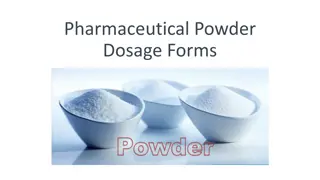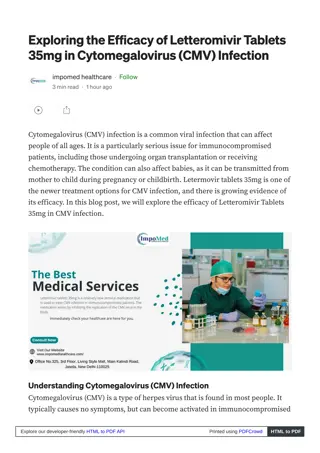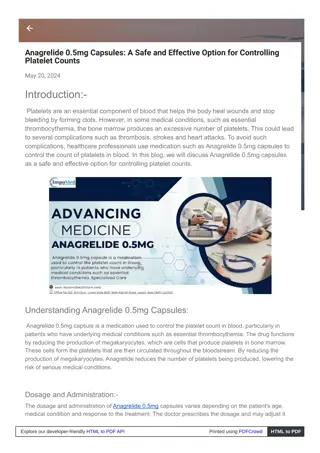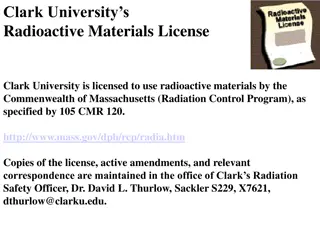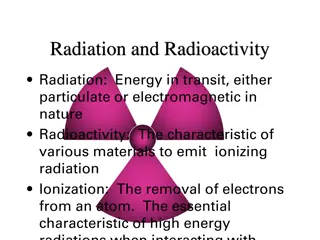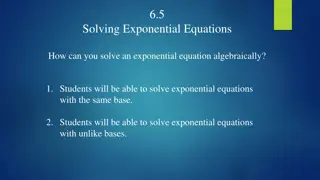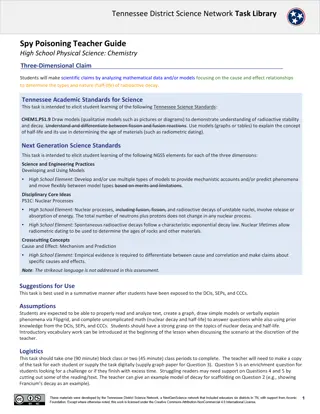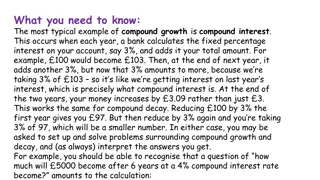Understanding Exponential Decay in Ibuprofen Dosage
Explore the concept of exponential decay using an example of ibuprofen dosage elimination from the bloodstream. Learn how to calculate the remaining dosage at different time intervals based on the decay rate. Discover the relation between the initial dosage, elimination rate, and time passed.
Download Presentation

Please find below an Image/Link to download the presentation.
The content on the website is provided AS IS for your information and personal use only. It may not be sold, licensed, or shared on other websites without obtaining consent from the author. Download presentation by click this link. If you encounter any issues during the download, it is possible that the publisher has removed the file from their server.
E N D
Presentation Transcript
Exponential Decay All slides in this presentations are based on the book Functions, Data and Models, S.P. Gordon and F. S Gordon ISBN 978-0-88385-767-0
Ibuprofen Example Ibuprofen is used to treat pain and to reduce joint swelling caused by conditions like arthritis. When you take a dose it is absorbed into your bloodstream and is then filtered out of the blood by the kidney The kidney eliminates approximately 30% of the ibuprofen in the bloodstream during any 1-hour period. Therefore 70% of the drug remains. Suppose we take a 400mg dosage of ibuprofen. How much remains after 1 hour? p. 2
Ibuprofen Example Continued How much remains after 1 hour? Answer: Let L(t) be the amount that remains after t hours, so we have: ? 0 = 400?? ??? ? 1 = 0.7 400 = 280 (? ??) How much remains after the 2nd hour? Answer ? 2 = 0.7 280 = 196?? = 0.7 ? 1 How much remains after the 3rd hour? Answer: ? 3 = 0.7 ? 2 = 0.7 196 = 137.2 ?? p. 3
Finding the Exponetial Equation ?????? ? 0 = 400?? ? 1 = 0.7 ? 0 = 280?? ? 2 = 0.7 ? 1 ?? ??? ?????????? ? ? ????? ?? ? 1 ???? ????? ??? ??? ? 2 = 0.7 0.7 ? 0 = 0.72 400 ? 3 = 0.7 ? 2 = 0.7 (0.72 400) = 0.73 400 Can you guess what the equation of L(t) should be? Answer ? ? = 400 0.7? p. 5
Exponential Decay Our equation is ? ? = 400 0.7? This equation is the same form of the equation we studied in section 5.1 ? = ??? But now 0 < ? < 1 whereas in section 5.1 ? > 1 (??? ?????? 5.19 p. 6
Decay Factor Suppose that some process decreases at a rate of 12% per year. This 12% = 0.12 is known as the decay rate and the associated factor b is Decay Factor = 1 Decay Rate In our example, the Decay Factor b = 1 Decay Rate = 1 - 0.12 = 0.88 By comparison, for exponential growth, we have: Growth factor = 1 + Growth Rate p. 7
Example Example 1 Find the amount of ibuprofen in the bloodstream after 7 hours based on an initial dose of 400 mg. Solution: We use the formula for exponential decay. (Why?) ? ? = 400(0.70)? After 7 hours we have: ? 7 = 400(0.70)7 32.9417 Or slightly less than 33 mg p. 8
Example Example 2 Estimate how long it takes until the level of Ibuprofen in the bloodstream drops to 10 mg? Solution: Using the formula for the level of Ibuprofen, we must find t ? ? = 400(0.70)?= 10 Solving graphically on our TI calculator We enter two equations p. 9
Example Continued Solution Intersection of two curves is solution Adjust window (Why these values?) Find the value of x where lines intersect Since we are interested when L(t) will be 10, we write a second equation Enter the equations @ ` % 5 ! After 7 hours approximately 10.34 mg of Ibuprofen will remain in the bloodstream p. 10
Exponential Decay Formula See figure 5.21 The larger the decay rate, and hence the smaller the decay factor b, the faster the function dies out and approaches 0. p. 11
Half Life Just as the doubling time for an exponential growth process is the time needed for the quantity to double, the half life for an exponential decay process is the time T needed for the quantity to be reduced by half. (see figure 5.22) p. 12
Example Half Life Example 3 Estimate the half life of Ibuprofen in the bloodstream following a 400 mg dose. Solution: The exponential decay function that models the amount of Ibuprofen in the bloodstream is ? ? = 400(0.70)? We want the time t needed for this level to drop to 1 2400 = 200?? So we have 400(0.70)?= 200 p. 13
Example Half Life Continued Solution Intersection of two curves is solution Adjust window (Why these values?) Find the value of x where lines intersect Since we are interested when L(t) will be 200, we write a second equation Enter the equations ` % @ 5 ! It takes almost 2 hours (1.94 hours) for the level of Ibuprofen in your bloodstream to be half the amount present, two hours earlier. p. 14
Example Example 4 Prozac is one of the most widely used medications to treat severe depression. The typical dose is 40 mg. In any 24-hour period, about 25% of the Prozac is eliminated. Find a formula for the amount of Prozac P in the bloodstream t days after a single initial dosage. a. Solution: The initial amount is 40 mg and the decay rate is 25% = 0.25 Therefore the decay factor is 1 0.25 = 0.75 and the amount of Prozac in the bloodstream after t days is ? ? = 40(0.75)? p. 15
Example Continued b. Estimate the half life of Prozac. Solution: To find the half life we need to solve the equation Therefore the decay factor is 1 0.25 = 0.75 and the amount of Prozac in the bloodstream after t days is 40(0.75)?= 20 Solution Since we are interested when P(t) will be 20, we write a second equation ! Intersection of two curves is solution % Adjust window (Why these values?) Find the value of x where lines intersect Enter the equations @ ` 5 The half life of Prozac is about 2.4 days p. 16
Example Example 5 The half life of aspirin is 29 minutes. Determine the corresponding decay rate and write a formula for the amount of aspirin in the blood following a dose of two 325 mg tablets Solution: The formula for the level L of aspirin in the blood t minutes after two tablets are absorbed into the blood is an exponential decay function of the form: ? ? = ?(?)? Now ? = 325 2 = 650 ?? 650?29=1 2650 = 325 ?29=325 1 29 0.9764 650?29= 325 ?? 650?29= 325 29.5 = 0.5 650= 0.5 ? = Decay Rate = 1 Decay Factor = 1 0.9764 = 0.0236 = 2.36% The formula for the amount of aspirin that remains in the blood after t minutes is for a 650 mg dose ? ? = ???(?.????)? p. 17
Radioactive Decay Radioactive substances transform or decay into other elements, often lead, as time passes. The rate at which an element decays is specific to that element. Over the course of 100 years, approximately 4.3% of any radium will decay to lead. Therefore 95.7% of the original amount of the radium remains after 100 years. This situation can be represented by an exponential decay function p. 18
Example Example 6 Estimate the half-life of radium. Solution: We use the formula for exponential decay. (Why?) ? ? = (0.957)??0 Half-life equation: ? ? = (0.957)??0=1 2?0 p. 19
Example Continued Solution Intersection of two curves is solution Adjust window (Why these values?) Find the value of x where lines intersect Since we are interested when R(t) will be 0.5, we write a second equation Enter the equations ` % @ 5 ! The half life of Radium is about 1577 years (100*15.77) p. 20
Example Example 7 Radioactive iodine is used in the diagnosis and treatment of thyroid problems. It has a half-life of about 8 days. If an initial dosage of ?0?? ????? ?? ? ??????? Find the associated decay rate and write a formula for the amount present in the blood as a function of time p. 21
Example Solution: Half-life equation: ?0 ?8=1 ?8=1 2?0 80.5 0.9170 2 ? = Decay Rate = 1 0.9170 = 0.0830 The formula for the amount present in the blood at time t is: ? ? = ?00.9170? p. 22



